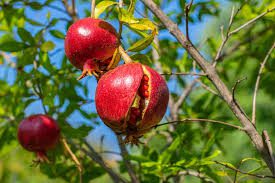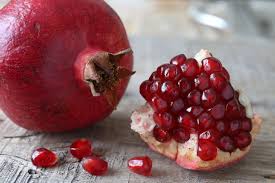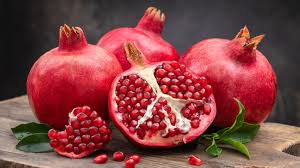Pomegranates scientifically known as Punica granatum are amazing fruits with a tough, reddish outer skin. When you cut them open, you discover a treasure trove of jewel-like seeds nestled in juicy, ruby-red pulp. These seeds, called arils, burst with a delightful blend of sweetness and tartness, creating a flavor that dances on your taste buds.
One remarkable thing about pomegranates is their rich history. They have been cherished for centuries, symbolizing fertility, health, and prosperity in various cultures. Ancient civilizations, from Persia to Egypt, held these fruits in high esteem, considering them not just as food but as symbols of life and abundance.
Beyond their cultural significance, pomegranates pack a punch in the nutrition department. Loaded with antioxidants, they are like little warriors defending your body against harmful molecules. Antioxidants help keep your cells healthy and may even contribute to a lower risk of chronic diseases. Plus, pomegranates are a great source of vitamin C, which is fantastic for your immune system.
Not just a taste sensation and nutritional powerhouse, pomegranates also bring a touch of versatility to your table. You can enjoy them in various forms – as fresh arils, in juices, or as part of salads, desserts, and sauces. The possibilities are as vast as your imagination.
What’s more, some studies suggest that pomegranates might have heart-healthy benefits. They may help lower blood pressure and improve cholesterol levels, which is great news for your cardiovascular system. Imagine, a fruit that not only delights your senses but also loves your heart back!
Pomegranates are not just about the flesh and seeds; even their peels have garnered attention. Some people use pomegranate peel extracts for medicinal purposes, believing in its potential to combat inflammation and support overall well-being.
Growing a pomegranate tree can be a rewarding experience. Picture having your own supply of these vibrant fruits, plucked fresh from the tree. The process of watching the flowers transform into the tough-skinned orbs is like witnessing nature’s magic unfold in your backyard.
Additionally, pomegranates are not just fruits; they are timeless gems, revered across cultures, celebrated for their taste, and valued for their health benefits. So, the next time you savor the juicy arils of a pomegranate, remember you’re enjoying not just a fruit but a piece of history and a burst of goodness for your body and soul.
Read Also: Importance of Multivitamins in Poultry Production
The History of Pomegranates (Punica granatum)

Pomegranates have a history as rich and vibrant as their ruby-red arils. Originating in the region stretching from Iran to northern India, these fruits have been cultivated for thousands of years. Ancient texts and artworks reveal that pomegranates held significant cultural and symbolic importance in various civilizations.
In ancient Persia, pomegranates were a symbol of fertility, abundance, and prosperity. They found their way into art, literature, and religious rituals. The fruit’s association with fertility made it a common motif in Persian art, often depicted in paintings and sculptures.
The ancient Egyptians also embraced the pomegranate, considering it a symbol of life and regeneration. Archaeological findings suggest that Egyptians consumed pomegranates and used them in various ceremonies. The fruit’s significance extended to burial practices, where it was sometimes placed in tombs to ensure a fruitful afterlife.
As trade routes expanded, pomegranates journeyed to Greece, where they became intertwined with mythology. In Greek mythology, the story of Persephone, the goddess of the underworld, involves her eating pomegranate seeds, which binds her to the underworld for a portion of the year. This tale symbolizes the changing seasons, with the pomegranate representing the cycle of life, death, and rebirth.
Moving forward in history, pomegranates became associated with religious symbolism in Judeo-Christian traditions. Some interpretations suggest that the fruit mentioned in the Bible, often referred to as the “apple” in the story of Adam and Eve, might actually be a pomegranate.
Throughout the centuries, the allure of pomegranates continued to spread. The fruit appeared in ancient Chinese medicine, where its medicinal properties were acknowledged. Over time, pomegranates made their way into various cuisines and became a staple in Middle Eastern, Mediterranean, and South Asian dishes.
In modern times, scientific studies have explored the health benefits of pomegranates, confirming what ancient cultures intuitively knew. The antioxidants and nutrients in pomegranates contribute to overall well-being, making them not just a cultural icon but also a valuable component of a healthy diet.
In essence, the history of pomegranates is a tapestry woven with threads of cultural symbolism, mythology, and practical uses. From the palaces of Persia to the gardens of ancient Greece, the journey of the pomegranate reflects the enduring fascination humans have had with this remarkable fruit.
The Nutritional Values of Pomegranates (Punica granatum)

Pomegranates boast an impressive nutritional profile, making them a powerhouse of essential nutrients. These juicy gems are not just a delight for the taste buds; they also contribute to overall health and well-being.
First and foremost, pomegranates are rich in antioxidants. These compounds, including polyphenols and anthocyanins, help combat oxidative stress in the body. Antioxidants play a crucial role in neutralizing harmful free radicals, potentially reducing the risk of chronic diseases and supporting cellular health.
Vitamin C is another standout nutrient found abundantly in pomegranates. This vitamin is essential for a healthy immune system, promoting the production of collagen for skin health, and acting as an antioxidant. A single serving of pomegranate can provide a significant portion of your daily vitamin C needs.
The arils, or seeds, are the edible part of the pomegranate and are a good source of dietary fiber. Fiber is essential for digestive health, aiding in regular bowel movements and supporting a feeling of fullness, which can be beneficial for weight management.
Pomegranates also contain a small amount of vitamin K, which plays a role in blood clotting and bone health. Additionally, they provide trace amounts of other vitamins and minerals, contributing to a well-rounded nutritional profile.
Studies suggest that regular consumption of pomegranates may have cardiovascular benefits. The antioxidants in pomegranates may help lower blood pressure, reduce cholesterol levels, and improve overall heart health. These potential cardiovascular benefits add to the appeal of incorporating pomegranates into a heart-healthy diet.
It’s worth noting that while pomegranates offer numerous health benefits, moderation is key, especially for individuals monitoring their sugar intake. Pomegranate juice, in particular, can be high in natural sugars, so it’s advisable to consume it in moderation as part of a balanced diet.
In addition, pomegranates are not only a delicious and visually stunning fruit but also a nutritional powerhouse. From antioxidants to vitamins and fiber, they bring a spectrum of health benefits, making them a delightful addition to your diet.
Read Also: Importance of Poultry Management Practices
The Health Benefits of Pomegranates (Punica granatum)

Pomegranates are a treasure trove of health benefits, contributing to overall well-being in various ways. Here are some notable advantages associated with the consumption of these vibrant fruits:
1. Rich in Antioxidants: Pomegranates are packed with powerful antioxidants, such as polyphenols and anthocyanins. These compounds help neutralize free radicals in the body, potentially reducing the risk of chronic diseases and supporting cellular health.
2. Heart Health: Studies suggest that regular consumption of pomegranates may have positive effects on heart health. The antioxidants in pomegranates may contribute to lower blood pressure, reduced cholesterol levels, and improved overall cardiovascular function.
3. Anti-Inflammatory Properties: Pomegranates contain natural anti-inflammatory compounds, which may help alleviate inflammation in the body. Chronic inflammation is linked to various health conditions, and the anti-inflammatory properties of pomegranates may offer protective effects.
4. Boosts Immunity: The high vitamin C content in pomegranates is beneficial for the immune system. Vitamin C is known to support the production and function of white blood cells, which play a crucial role in the body’s defense against infections.
5. Digestive Health: Pomegranates are a good source of dietary fiber, promoting healthy digestion. Fiber adds bulk to the stool, preventing constipation and supporting the overall health of the digestive system.
6. Cancer Prevention: Some studies suggest that the antioxidants in pomegranates may have potential anti-cancer properties. While more research is needed, there is emerging evidence that certain compounds in pomegranates could inhibit the growth of cancer cells.
7. Joint Health: Pomegranates may have benefits for joint health due to their anti-inflammatory properties. Some research indicates that pomegranate extract may help alleviate symptoms associated with arthritis.
8. Skin Health: The antioxidants in pomegranates contribute to skin health by helping combat oxidative stress. Additionally, the fruit’s vitamin C content plays a role in collagen production, promoting healthy and radiant skin.
9. Memory and Cognitive Function: Preliminary studies suggest that pomegranates may have a positive impact on memory and cognitive function. The antioxidants in these fruits may help protect the brain from age-related decline.
10. Diabetes Management: While more research is needed, some studies suggest that pomegranates may have a role in managing blood sugar levels. The anti-inflammatory and antioxidant properties may contribute to improved insulin sensitivity.
Incorporating pomegranates into a balanced and varied diet can be a flavorful way to enjoy these health benefits. However, it’s important to remember that individual responses may vary, and consulting with a healthcare professional is advisable, especially for those with specific health concerns or conditions.
How to Grow Pomegranates (Punica granatum)
Growing pomegranates can be a rewarding experience, allowing you to enjoy fresh, homegrown fruits. Here’s a simple guide on how to grow pomegranates:
1. Choose the Right Variety: Select a pomegranate variety suitable for your climate. Some popular varieties include ‘Wonderful’ and ‘Haku Botan.’ Consider consulting with local nurseries for advice on the best varieties for your region.
2. Climate and Location: Pomegranates thrive in warm to hot climates. They prefer full sun but can tolerate a variety of soil types. Ensure good drainage to prevent waterlogged soil, which pomegranates dislike.
3. Planting: Plant pomegranates in late winter to early spring. Dig a hole twice as wide and deep as the root ball. Place the plant in the center, backfill with soil, and water thoroughly.
4. Watering: Pomegranates are drought-tolerant once established but benefit from regular watering during dry spells. Water deeply and allow the soil to dry out between watering. Avoid overwatering, as pomegranates are sensitive to waterlogged conditions.
5. Mulching: Apply a layer of organic mulch, such as bark or compost, around the base of the tree. Mulching helps retain soil moisture, suppress weeds, and regulate soil temperature.
6. Pruning: Prune pomegranate trees to encourage a strong structure. Remove any dead or damaged branches and suckers at the base. Pruning can be done in late winter or early spring.
7. Fertilizing: Fertilize pomegranates in spring with a balanced, slow-release fertilizer. Follow the package instructions, and avoid excessive nitrogen, as it can promote vegetative growth at the expense of fruiting.
8. Pest Control: Keep an eye out for pests such as aphids and scale insects. Insecticidal soap or neem oil can help control these pests. Monitor for diseases like fungal infections and treat promptly if needed.
9. Harvesting: Pomegranates typically ripen in the fall. Harvest when the fruit has developed its characteristic color and sounds metallic when tapped. Cut the fruit from the tree, leaving a small part of the stem attached.
10. Storage: Store harvested pomegranates in a cool, dry place. They can last for several weeks when stored properly. Alternatively, you can extract the arils and freeze them for longer storage.
Remember that successful pomegranate cultivation may vary depending on your specific climate and soil conditions. Regular monitoring, care, and patience are key to growing healthy and fruitful pomegranate trees.
